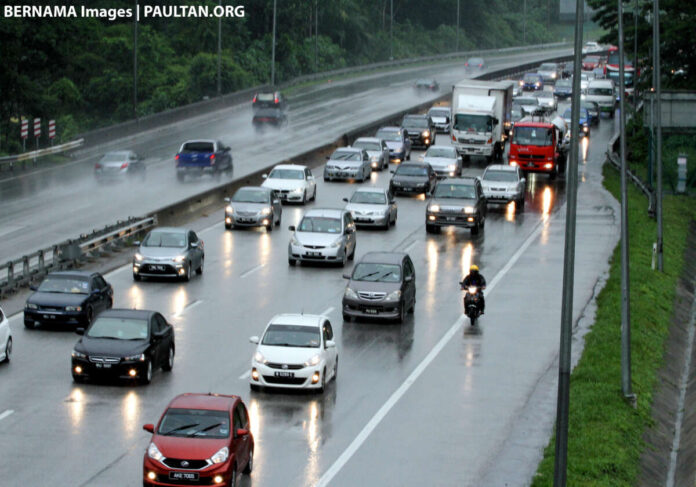With the spate of rainy weather in Malaysia, incidents of hydroplaning, or aquaplaning, are occurring more often. Just two days ago we were on the highway, riding a motorcycle heading north, and witnessed two incidents of hydroplaning happen directly in front of us.
In both cases, the cars spun, slowed and came to a stop without hitting anything. The drivers were more shocked than anything else, but, what is hydroplaning and what can you, as the driver, do to prevent it or at least, remain in control and recover?
Hydroplaning occurs when water builds up under the contact patch of the tyre(s), causing the tyre to lift and lose adhesion with the road surface. A driver will usually feel this as the steering wheel going suddenly light, then wobbling slightly, before control is lost and everything goes sideways due to the tyres unequal traction.
Several factors directly cause aquaplaning, first and foremost of which is road speed. When road conditions are bad, it is always prudent to slow slightly, pay attention and exercise caution especially with regard to braking distance to the vehicle in front.

While there are some Malaysian drivers who believe and trust in the safety technology installed in their vehicle, every safety system has its limitations. ABS, traction control, electronic stability control, emergency braking and brake assist are technologies that work well and prevent accidents but all require the driver to be in control of the vehicle at all times.
The other main factor affecting hydroplaning is the vehicle’s tyres. In this case, proper tyre inflation pressure should be maintained. Over- and under-inflation will both lead to the vehicle having a propensity for hydroplaning.
Tyre tread depth should also be checked, and if very near or at the wear limit indicators, tyres should be changed either as a pair, or as a full set. In any case, uneven wear on tyres is a cause for concern and indicative of a problem either in the steering alignment or suspension which should be addressed on an immediate basis.
Another factor to be considered is the weight of the vehicle. A very light vehicle, or one that is heavily overloaded, will hydroplane more readily. Try to ensure weight is evenly distributed in the vehicle and balanced fore and aft.

So, what do you do when your car starts to hydroplane? In some cases we witnessed, the immediate reaction of the driver is the jam hard on the brakes to slow the car down but sends the car into a skid. Technically this is when ABS activates to stop the skid and EBD redistributes braking force between the wheels to allow the car to regain stability.
What you can do as a driver is… get better driver training. Steering into and out of skids is not covered in the current Malaysian driving school curriculum, and neither is braking technique, aside from the driving instructor telling you, “just jam the brakes on as hard as you can.”
When your vehicle starts to hydroplane, don’t brake hard or jam on the brakes, instead let the weight of the car settle and allow the tyres to regain traction, then steer into or out of the skid as circumstances dictate. The rule of thumb is you want your steering to be pointing in the direction in which your vehicle is travelling, then reducing steering angle as the car straightens out.
Avoid sudden movements of the steering wheel, or any sudden braking. These serve to upset the balance of the vehicle, leading to an out of control situation.

It is hard to suppress the immediate reaction to emergency brake when you feel you have lost control of the vehicle and indeed, professional drivers train hard against this natural tendency. You should at all times have both hands on the wheel with your seat adjusted to the correct driving position, allowing you to retain command of the important things that control your vehicle when traction is lost, i.e. the steering wheel, accelerator and brake.
Selection of your tyres is as important, as these are the primary contact point between your vehicle and the road. Tyres are not created equal and typically certain brands have a reputation for better wet weather performance than others.
The size of your tyre also plays a part, with a tall, narrow width tyre having less of a tendency to hydroplane than wide profile rubber. Tyre tread type and depth also plays an important part, as mentioned earlier, with some tread patterns specifically designed for all weather and wet weather use while it is best to leave the high performance track tyres for where they should be, at the track.
Road surface is an issue, especially in wet weather. Tarmac tends to offer better grip in wet weather than concrete due to surface porosity and try to avoid puddles and standing water.
Most importantly, keep an eye on your vehicle’s speed and exercise caution. Plan your journey, ensure your vehicle is in road worthy condition and check the weather forecast. Safety on the road is your responsibility.
Looking to sell your car? Sell it with Carro.

